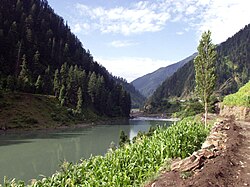| Jhelum | |
|---|---|
 Jhelum River photographed in Pakistan, c. 2006 | |
 | |
| Location | |
| Countries | India, Pakistan |
| Physical characteristics | |
| Source | |
| • location | Verinag Spring |
| • coordinates | 33°32′05″N75°14′59″E / 33.53472°N 75.24972°E |
| Mouth | |
• location | Chenab River at Trimmu, Jhang District |
• coordinates | 31°10′N72°09′E / 31.17°N 72.15°E |
| Length | 725 km (450 mi) |
| Discharge | |
| • average | 1,026.6 m3/s (36,250 cu ft/s) (near Mangla Dam) |
| • minimum | 234.19 m3/s (8,270 cu ft/s) (near Mangla Dam) |
| • maximum | 26,419.13 m3/s (932,983 cu ft/s) (near Mangla Dam) |
| Discharge | |
| • average | 313.19 m3/s (11,060 cu ft/s) (near Domel) |
| Discharge | |
| • average | 229.20 m3/s (8,094 cu ft/s) (near Baramulla) |
| Basin features | |
| River system | Indus River |
| Tributaries | |
| • left | Poonch River, Sukhnag River, Veshaw River, Rambiara River, Ramoshi River, Doodh Ganga,Ferozpur Nalla River, Ningle Nalla, Pohru River |
| • right | Arpath River, Lidder River, Kishanganga River/Neelum River, Sind River, Kunhar River, Pohru River, Erin River |
The Jhelum River [a] is a major river in South Asia, flowing through India and Pakistan, and is the westernmost of the five major rivers of the Punjab region. It originates at Verinag in Indian-administered Jammu and Kashmir, flows into Pakistan-administered Azad Jammu and Kashmir, and then through the Punjab province of Pakistan. It is a tributary of the Chenab River and has a total length of about 725 kilometres (450 mi). [6]














